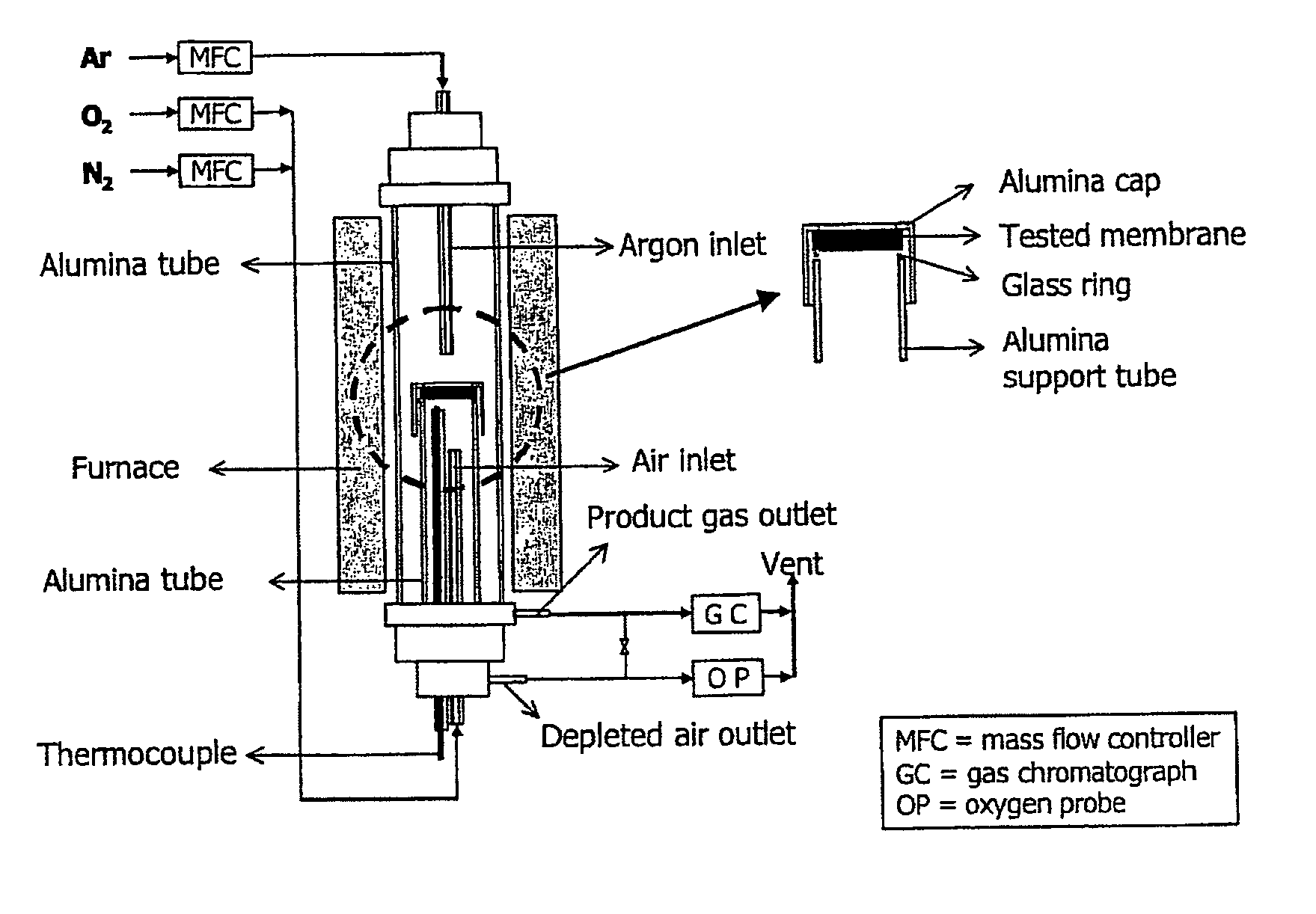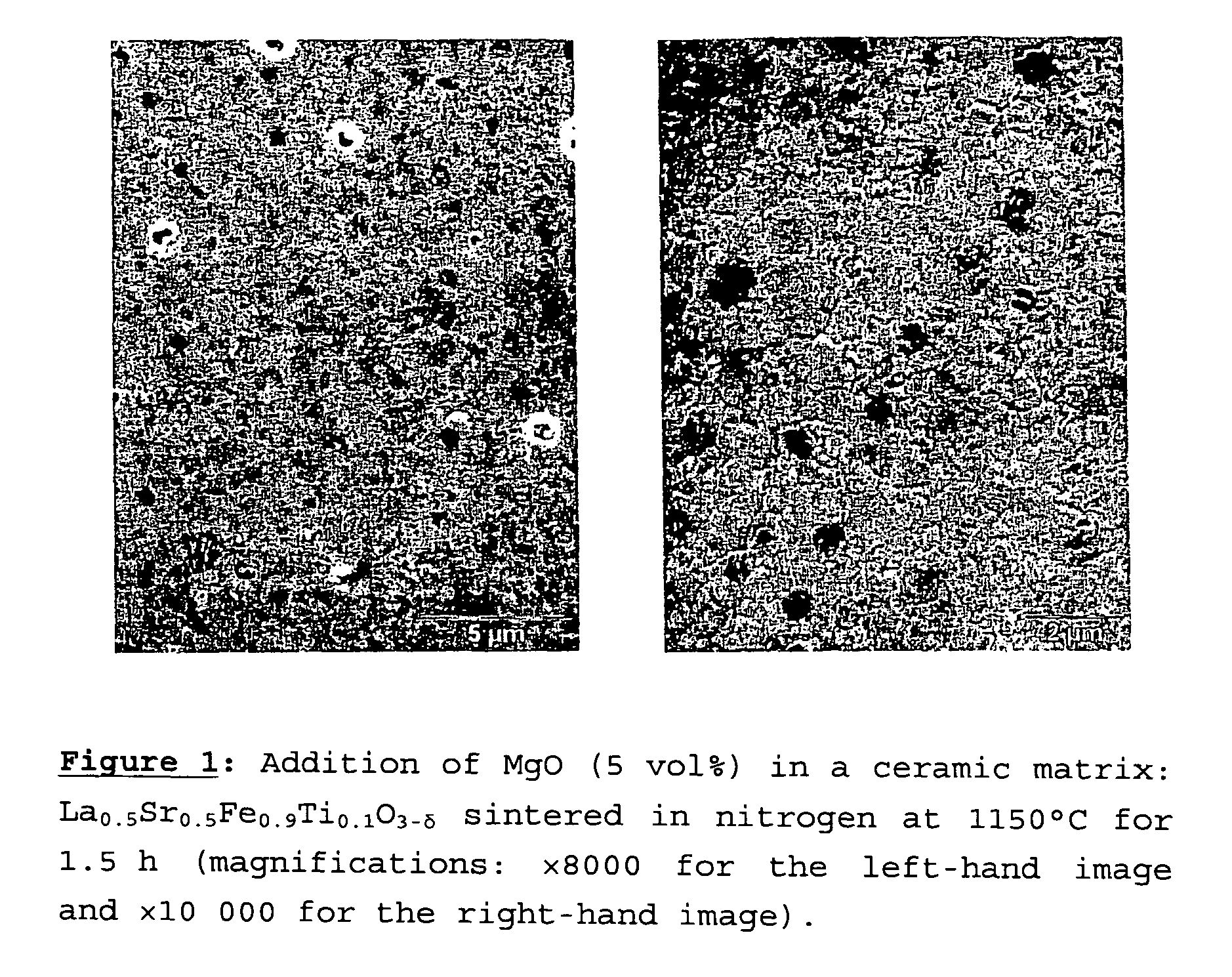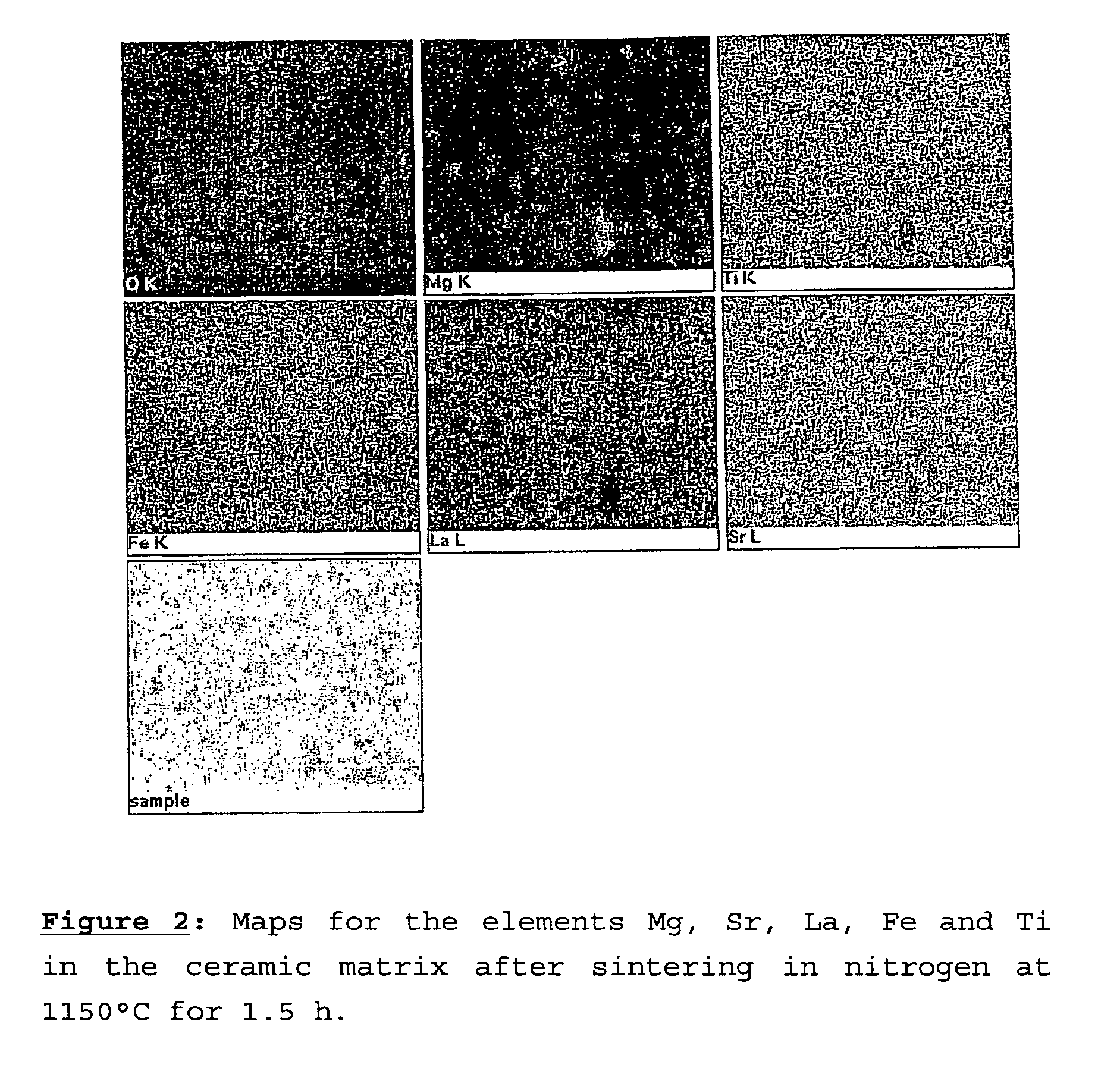Addition of (a) blocking agent(s) in a ceramic membrane for clocking crystalline growth of grains during atmospheric sintering
a technology of blocking agent and ceramic membrane, which is applied in the direction of organic conductor, conductive material, conductive material, etc., can solve the problems of limiting the lifetime of the system, brittle ceramic behavior, mechanical properties, and increased grain size, so as to reduce the porosity, minimize grain growth, and reduce the effect of grain siz
- Summary
- Abstract
- Description
- Claims
- Application Information
AI Technical Summary
Benefits of technology
Problems solved by technology
Method used
Image
Examples
example 1
MgO (5 vol %) / La0.5Sr0.5Fe0.9Ti0.1O3−δ (95 vol %) Ceramic Membrane
[0082]The example presented is a blend according to the protocol described above, consisting of 5 vol % magnesia (MgO) (compound C2) and 95 vol % of the ceramic La0.5Sr0.5Fe0.9Ti0.1O3−δ (compound C1). The sintering was carried out in nitrogen at 1150° C. for 1.5 h.
[0083]FIG. 1 shows two images obtained by scanning electron microscopy with two different magnifications (FIG. 1a: ×8000 and FIG. 1b: ×10000). These images show that the MgO grains are distributed uniformly within the matrix, and have a size of less than 1 μm. The La0.5Sr0.5Fe0.9Ti0.1O3−δ grains are all smaller than 2 μm.
[0084]An La0.5Sr0.5Fe0.9Ti0.1O3−δ membrane containing no MgO and sintered under the same conditions (in nitrogen at 1150° C. for one hour and a half) had grain sizes of between 2 and 3 μm.
[0085]FIG. 2 shows maps of the constituent elements of the membrane, obtained by EDS analysis. It may be seen that all the elements are uniformly distribut...
example 2
MgO (5 vol %) / La0.6Sr0.4Fe0.9Ga0.1O3−δ 95 vol %) Ceramic Membrane
[0086]The example presented is a blend according to the protocol described above, consisting of 5 vol % magnesia (MgO) (compound C2) and 95% of the ceramic La0.6Sr0.4Fe0.9Ga0.1O3−δ (abbreviated in the figures to LSFG; compound C1). The sintering was carried out in nitrogen at 1235° C. for two hours.
[0087]FIG. 3 shows by X-ray diffraction the fact that the MgO (40 vol %) / La0.6Sr0.4Fe0.9Ga0.1O3−δ (60 vol %) blend does not result, after being calcined at 1200° C. for a few hours in nitrogen, in any new compounds. The X-ray diffraction diagram demonstrates that there is no chemical reactivity between the MgO blocking agent and the La0.6Sr0.4Fe0.9Ga0.1O3−δ ceramic matrix.
[0088]FIG. 4 shows by X-ray diffraction that the BaTiO3 (40 vol %) / La0.6Sr0.4Fe0.9Ga0.1O3−δ (60 vol %) blend does not result, after being calcined in nitrogen at 1200° C. for a few hours, in any new compounds. The X-ray diffraction diagram demonstrates tha...
example 3
Influence of the Presence of Magnesium Oxide (MgO) in La0.6Sr0.4Fe0.9Ga0.1O3−δ (LSFG) on the Oxygen Permeability of the Membrane
a) Preparation of the Specimens
[0092]LSFG and MgO powders were weighed and blended in different proportions by volume in order to obtain compositions comprising (100−x) vol % LSFG and x vol % MgO, where x=0; 2; 5.
[0093]Dense membranes with a thickness of about 1 mm and an area of 3.1 cm2 were prepared from these compositions (LSFG (x=0); LSFG / 2M (x=2); LSFG / 5M (x=5)) using the tape casting process described in The Encyclopedia of Advanced Materials, Volume 4, Pergamon 1994, Cambridge, 2763-2767 by T. Chartier, and in which the binder removal step was carried out with a slow heating rate and the sintering step was carried out between 1250° C. and 1350° C. for 2 h in a 90% nitrogen / 10% oxygen atmosphere. The permeation measurements were carried out with the device shown in FIG. 8, consisting of a tube furnace and gas feeds and analyzers (gas chromatography—YS...
PUM
| Property | Measurement | Unit |
|---|---|---|
| diameter | aaaaa | aaaaa |
| volume fraction | aaaaa | aaaaa |
| volume fraction | aaaaa | aaaaa |
Abstract
Description
Claims
Application Information
 Login to View More
Login to View More - R&D
- Intellectual Property
- Life Sciences
- Materials
- Tech Scout
- Unparalleled Data Quality
- Higher Quality Content
- 60% Fewer Hallucinations
Browse by: Latest US Patents, China's latest patents, Technical Efficacy Thesaurus, Application Domain, Technology Topic, Popular Technical Reports.
© 2025 PatSnap. All rights reserved.Legal|Privacy policy|Modern Slavery Act Transparency Statement|Sitemap|About US| Contact US: help@patsnap.com



